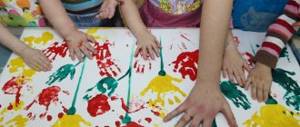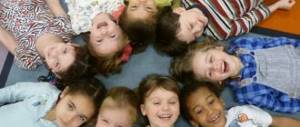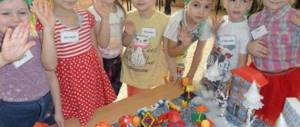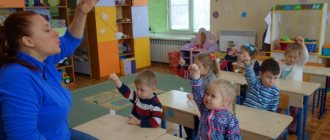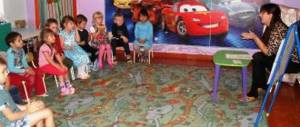Didactic game on gender education “Let’s dress a boy and a girl”»
In the fourth year of life, interest in communicating with peers develops. Relationships between children arise on the basis of interest in actions with attractive objects and toys. These actions gradually acquire a joint, interdependent character.
One of the main types of children's activities is play. Play is a favorite activity of younger preschoolers. It is the game that allows children to become more involved in current life in forms of intellectual and active practical activity, moral and aesthetic experiences that are accessible to them. It is precisely this that provides favorable conditions for solving pedagogical problems, taking into account the capabilities of preschool children.
Games are an essential element of a child’s development and upbringing. Didactic games help to establish relationships between practical and mental activities, which is important for children of any age.
Game description:
1. silhouettes of dolls (girl and boy)
2. sets of clothes in four main colors:
— a set of clothes for a boy
— a set of clothes for girls
The game elements are attached using Velcro.
Material:
Making silhouettes of dolls, sets of clothes from thick cardboard
The didactic manual “Dressing a Boy and a Girl” is intended for activities and games with children aged 3 to 4 years.
This game can be used both in class and in independent activities.
The didactic game promotes:
- formation of children’s ideas about a person (about parts of the body, distinguishing a person’s gender);
- development of fine motor skills;
— formation of self-service skills;
— development of sensory abilities;
— increasing cognitive activity;
— improvement of mental processes (sensation, attention, imagination, memory, thinking);
— consolidation of knowledge of the sequence of putting on clothes;
- consolidation of knowledge about clothes that suit a boy or
girl;
- enriching children's speech
— formation of friendly relationships and positive motivation for organized activities.
Akticheskaya ara “Dress Sasha
Progress of the game:
1. Invite the child to touch the fabric, and name what kind of fabric: (soft, smooth, thin, etc.)
.
Offer to find a pair for pieces of fabric (of a different color, but of the same quality)
.
2. Divide the fabric into two piles: fabric for winter and for summer. What is the difference?
"Drapery"
Goal: To improve children’s knowledge in distinguishing fabrics by quality and determining what clothes can be sewn from them, to consolidate knowledge of colors and their shades.
Didactic material
: scraps of fabric of different quality and color.
Progress: The teacher announces an auction for the sale of fabric. Explains what each participant can buy for their doll
a piece of fabric for any outfit, if it gives the correct description of the quality of the fabric, color and determines what product can be sewn from it.
«Dress for a walk
»
Goal: To introduce seasonal clothing; with clothes that suit a boy or a girl; development of fine motor skills.
Didactic material
:
Cardboard dolls
: boy and girl, sets of clothes for them for walks at different times of the year.
Progress: The teacher names the time of year, the children dress their dolls according to the season and to their liking.
"Clothing store"
Goal: consolidate children’s knowledge about the sales profession, cultivate a sense of respect and gratitude for the work performed;
Didactic material
: Flat clothing made from various fabrics.
Progress: The teacher announces that clothes for dolls are on sale. You can buy any clothes, but to do this you need to describe them. For example: “Please show me a blue sundress with flowers”
or
“I’d like to see a white shirt with a checkered tie
. Next, the role of the seller is played by one of the children.
"Fashion Show"
Goal: Developing a sense of taste, nurturing self-confidence; speech development.
Didactic material
: Cardboard
dolls
, a set of clothes made of cardboard with various materials glued on.
Progress: The child shows models of clothing and tells what fabric this item is made of. Skillful selection of clothing is encouraged.
Didactic games for preschoolers on the topic: “Clothes, shoes, hats.”
Author: Knis Anna Nikolaevna, senior teacher.
Place of work: MBDOU “Kindergarten No. 3 “Smile”, Kalach - on - Don. Description of work : I bring to your attention didactic games for preschoolers on the topic: “Clothes, shoes, hats.”
This material will help educators, children and their parents consolidate children’s knowledge about clothes, shoes and hats in a playful way. Didactic game: lotto “Clothes”.
Goal: To consolidate children’s knowledge about the variety of clothes, the ability to distinguish and find the right clothes.
Didactic material: Game field (4 pcs.), divided into 6 squares with images of various clothes, corresponding to the images on small cards (24 pcs.). Progress of the game: Game for children from 3 years old. The game can be played by 3-5 people. Players are given game cards. The presenter pulls out a small card from a special opaque bag, the player or presenter names the clothes shown on the card. Whoever finds the corresponding image on his field takes the picture for himself. This continues until one of the participants covers the entire playing field with pictures. Didactic game: lotto “Shoes and hats.”
Goal: To consolidate children’s knowledge about the variety of shoes and hats, the ability to distinguish and find the right shoes and hats.
Didactic material: Game field (4 pcs.), divided into 6 squares with images of various shoes and hats, corresponding to the images on small cards (24 pcs.). Progress of the game: Game for children from 3 years old. The game can be played by 3-5 people. Players are given game cards. The presenter pulls out a small card from a special opaque bag, the player or presenter names the headdress or shoes shown on the card. Whoever finds the corresponding image on his field takes the picture for himself. This continues until one of the participants covers the entire playing field with pictures. Didactic game “Dress Tanya and Vanya according to the season.”
Goal: Formation of children's ideas about clothing, hats and shoes, their connection with the season and weather.
Didactic material: Cards with images of clothes, shoes and hats, 30 pieces and four playing fields with images of Vanya, Tanya and the seasons. Progress of the game: Lay out cards with images of clothes, shoes and hats in accordance with the season and gender (for the girl Tanya to the right of the playing field, and for the boy Vanya to the left). Didactic game “Guess the clothes, shoes or headdress”
Purpose: To develop the ability to describe clothes, headwear or shoes and recognize them by description.
Didactic material: Cards with images of clothes, shoes and hats. Progress of the game: The teacher gives the children cards with pictures of clothes, shoes and hats. Children do not show their cards to anyone. The teacher invites one child to describe what is shown in his picture, or to ask a riddle. The other children must guess what is in the picture. For example: This is a headdress that girls wear in summer. It is made of straw. (Straw hat). These are shoes that boys and girls wear in spring or autumn after rain. It is tall and made of rubber. (Rubber boots). Didactic game “Collect a picture”
Goal: Development of logical thinking, outlook, cognitive interest and speech activity.
Didactic material: Cards with images of clothes, shoes and hats, cut into several parts. Progress of the game: Game for children from 3 years old. Children are given game cards cut into 2, 3, 4 parts (according to the age and abilities of the child). Having collected the picture, the child tells what he collected. For example: A green dress is clothing. Yellow boots, rubber ones - these are shoes. A gray earflap hat is a headdress. Didactic game “The fifth odd one”
Goal: Developing the ability to classify clothes, shoes and hats according to essential characteristics. Didactic material: Cards depicting 5 types of clothing, shoes and hats, 4 of them belong to one thematic group, and the fifth to another group. Progress of the game: Children are given the task: “Look at the pictures, name what is shown on them and determine which image is superfluous. Name the remaining images in one word.” Each participant eliminates the unnecessary image in turn. If he makes a mistake or does not complete the task, his version is offered to the next player to complete. For each correctly completed task they give a chip. The one who collects the most chips wins. For example: The card shows sandals, a raincoat, sneakers, flip flops and boots. The extra coat is because it is clothing and the rest is shoes.
Natalia Veselkova
One of the main types of gaming activity is didactic game
.
It is the didactic game
that allows children to become more involved in current life in forms of intellectual and active practical activity, moral and aesthetic experiences accessible to them. It is precisely this that provides favorable conditions for solving pedagogical problems, taking into account the capabilities of preschool children.
This didactic manual
“
Dress a doll for a girl or a boy”
forms in children an idea of a person, parts of the body, and the difference in a person’s gender.
Strengthens colors, develops fine motor skills, visual and effective thinking. Develops children's ability to distinguish and name items of clothing, and recognize them in pictures. Description: Two dolls made of thick felt
: boy and girl. Set of clothing items by color. The game elements are attached using Velcro.
1. A game
“Choose by color.”
Target. Learn to choose clothes of the same color to match the doll’s
; consolidate knowledge of primary colors (blue, red, yellow, green), develop attention, thinking, fine motor skills; cultivate neatness.
2. A game
"
Dress the boy
", "
Dress the girl
".
Goal: Develop the ability to differentiate clothes for boys and girls, name items of clothing, consistently dress a doll
.
Publications on the topic:
Role-playing game “Let’s feed the doll Masha” Role-playing game “Let’s feed the doll Masha.” Goal: -to promote interest in the work of adults, to form ideas about the purpose.
Didactic game “Dress the Tree” I bring to your attention the didactic game “Dress the Tree”. It is very simple to implement. Downloaded from.
The didactic game “Dress the Doll” is intended for children 2-4 years old. Purpose of the game: to teach the child to put together a whole from 3 parts, to introduce.
Didactic game “Dress the doll.” The age of children for whom the game is intended is 5-7 years. Purpose: to introduce items of clothing and their details.
PROGRAM TASKS: 1. To consolidate and clarify children’s knowledge about items of outerwear and the order of putting them on. 2. Enrich the plot of a children's game.
Summary of GCD for speech development “Dress the doll for a walk” GCD for speech development in the younger group. Examining the clothes of the Marinka doll. Dressing a doll for a walk. Purpose: to clarify children's ideas.
Summary of GCD for speech development. Didactic game for pronunciation of sounds [M]-[M'], [B]-[B']. Didactic game “Who left?” Goal: development of the articulatory apparatus. Objectives: 1. To develop the ability to clearly pronounce the sounds mm, b-b in sound combinations, to distinguish.
GCD for speech development in the middle group. Communicative activity “Description of clothing. Dress up the doll" Types of children's activities: play, communication, cognitive and research. Objectives: learn to describe items of clothing, select clothes.
Didactic task:
Strengthen children's ability to dress a doll according to the weather, correctly name items of clothing, and put them on in a certain sequence. Raise care for the doll.
Game task.
Dress the doll for a walk.
Game actions.
Dressing the doll.
Game rules.
Choose the necessary clothes, name them correctly, dress the doll in a certain sequence. Take only one item of clothing.
Material.
Doll, doll clothes, umbrella.
Progress of the game.
I tell the children that the doll Katya has already recovered and needs to go for a walk. But you need to dress the doll for a walk so that it doesn’t catch a cold again / i.e. according to the weather/.
I invite the children to choose the necessary clothes one by one, clarify the name of the items of clothing and the sequence of dressing.
If it’s cloudy outside, then I ask: “What else does the doll need to take for a walk?” /umbrella/.
After the doll is ready to go outside, the children also get dressed. The Katya doll “reminds” the dressing sequence and “clarifies” the names of clothing items for some children.
“Help dress the boy (girl) for a walk”
Target:
Introduce your child to seasonal clothing that is suitable for a boy or girl; fix the names of clothes; learn to choose clothes according to color and weather conditions.
An adult invites the children to help dress the boy and girl for a walk. Draws attention to the tree drawn on the box, decorated with additional elements (specifying that if the leaves are green, grass and flowers, then it is summer; autumn - yellow and red leaves, a cloud with rain, puddles; winter - snowdrifts and snow on the branches) clarifying time of year and reminding you to dress according to the weather.
